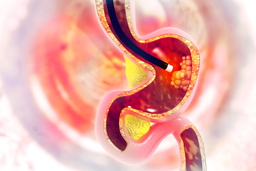Wide-Field MEMS-Based Endoscope
TECHNOLOGY NUMBER: 2019-035

OVERVIEW
A small flexible endoscope that uses a microelectromechanical systems (MEMS) scanner- Utilizes fluorescently labeled peptides to detect changes in mucosal tissues
- Enables simultaneous histologic evaluation of lesions in vivo
BACKGROUND
Gastrointestinal cancers are the second leading cause of cancer-related death. Conventional endoscopy is used to detect mucous, lesions, ulceration masses and polyps. Endoscopic procedures involve inserting a flexible tube with a light and an endoscope into the digestive tract, and they provide a direct visualization of the mucosa, allowing for the identification of abnormal growths, ulcers, and tumors., the diagnostic value of conventional endoscopy is limited, especially when evaluating lesions that are flat and visually indistinct. As such, improvements in existing endoscopic technologies could improve disease detection and eradication.
INNOVATION
Researchers have created a small flexible endoscope that uses a microelectromechanical systems (MEMS) scanner and which can be multiplexed with fluorescently labeled peptides to detect changes in mucosal tissues. Confocal laser endomicroscopy (CLE), which uses a laser rather than white light as a light source, allows for the mucosa to be examined with a small microscope placed on top of the endoscope, enabling simultaneous in vivo histologic diagnosis of lesions or even optical biopsy. This novel approach provides improved visualization of lesions that are flat, small, or which present in a patchy distribution.
The technique may be used to aid endoscopic evaluation of lesions in hollow organs such as the esophagus, stomach, and colon. This imaging system can be contained on a portable cart and can be used for "point-of-care‚" diagnostics in patients who require "test and treat" care. Because the diagnosis is provided instantaneously, patients receive immediate feedback on the pathology found. By only sampling the regions of tissue most likely to harbor disease, the number of biopsies taken may be minimized to reduce overdiagnosis.